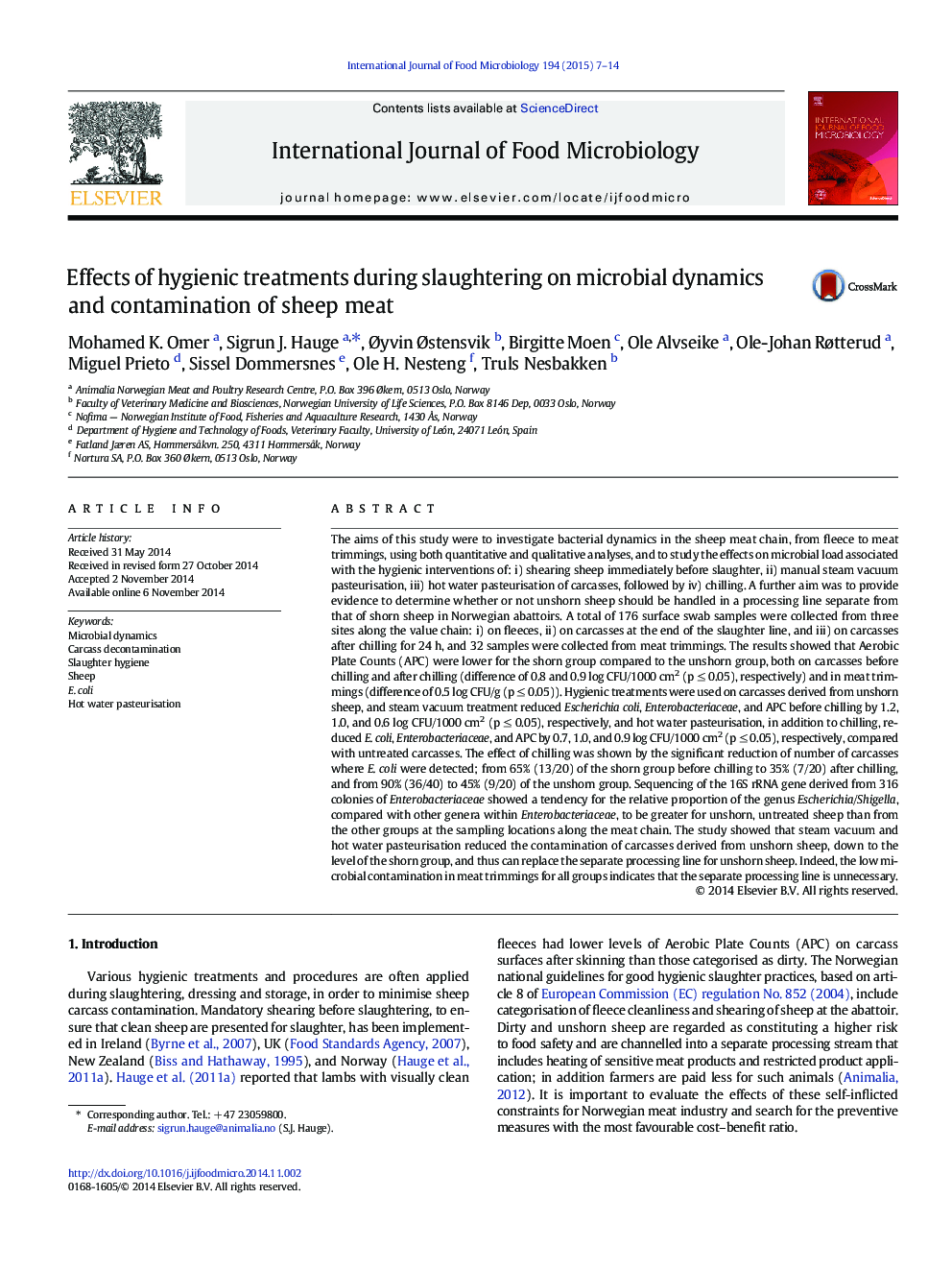| کد مقاله | کد نشریه | سال انتشار | مقاله انگلیسی | نسخه تمام متن |
|---|---|---|---|---|
| 4366686 | 1616589 | 2015 | 8 صفحه PDF | دانلود رایگان |
• Bacterial dynamics in the sheep meat value chain were studied.
• Hot water pasteurisation reduced microbial load on carcasses of unshorn sheep.
• Lower APC on carcasses of shorn lambs than unshorn lambs
• 16S rRNA: a greater relative proportion of E. coli from unshorn than shorn sheep
The aims of this study were to investigate bacterial dynamics in the sheep meat chain, from fleece to meat trimmings, using both quantitative and qualitative analyses, and to study the effects on microbial load associated with the hygienic interventions of: i) shearing sheep immediately before slaughter, ii) manual steam vacuum pasteurisation, iii) hot water pasteurisation of carcasses, followed by iv) chilling. A further aim was to provide evidence to determine whether or not unshorn sheep should be handled in a processing line separate from that of shorn sheep in Norwegian abattoirs. A total of 176 surface swab samples were collected from three sites along the value chain: i) on fleeces, ii) on carcasses at the end of the slaughter line, and iii) on carcasses after chilling for 24 h, and 32 samples were collected from meat trimmings. The results showed that Aerobic Plate Counts (APC) were lower for the shorn group compared to the unshorn group, both on carcasses before chilling and after chilling (difference of 0.8 and 0.9 log CFU/1000 cm2 (p ≤ 0.05), respectively) and in meat trimmings (difference of 0.5 log CFU/g (p ≤ 0.05)). Hygienic treatments were used on carcasses derived from unshorn sheep, and steam vacuum treatment reduced Escherichia coli, Enterobacteriaceae, and APC before chilling by 1.2, 1.0, and 0.6 log CFU/1000 cm2 (p ≤ 0.05), respectively, and hot water pasteurisation, in addition to chilling, reduced E. coli, Enterobacteriaceae, and APC by 0.7, 1.0, and 0.9 log CFU/1000 cm2 (p ≤ 0.05), respectively, compared with untreated carcasses. The effect of chilling was shown by the significant reduction of number of carcasses where E. coli were detected; from 65% (13/20) of the shorn group before chilling to 35% (7/20) after chilling, and from 90% (36/40) to 45% (9/20) of the unshorn group. Sequencing of the 16S rRNA gene derived from 316 colonies of Enterobacteriaceae showed a tendency for the relative proportion of the genus Escherichia/Shigella, compared with other genera within Enterobacteriaceae, to be greater for unshorn, untreated sheep than from the other groups at the sampling locations along the meat chain. The study showed that steam vacuum and hot water pasteurisation reduced the contamination of carcasses derived from unshorn sheep, down to the level of the shorn group, and thus can replace the separate processing line for unshorn sheep. Indeed, the low microbial contamination in meat trimmings for all groups indicates that the separate processing line is unnecessary.
Journal: International Journal of Food Microbiology - Volume 194, 2 February 2015, Pages 7–14
